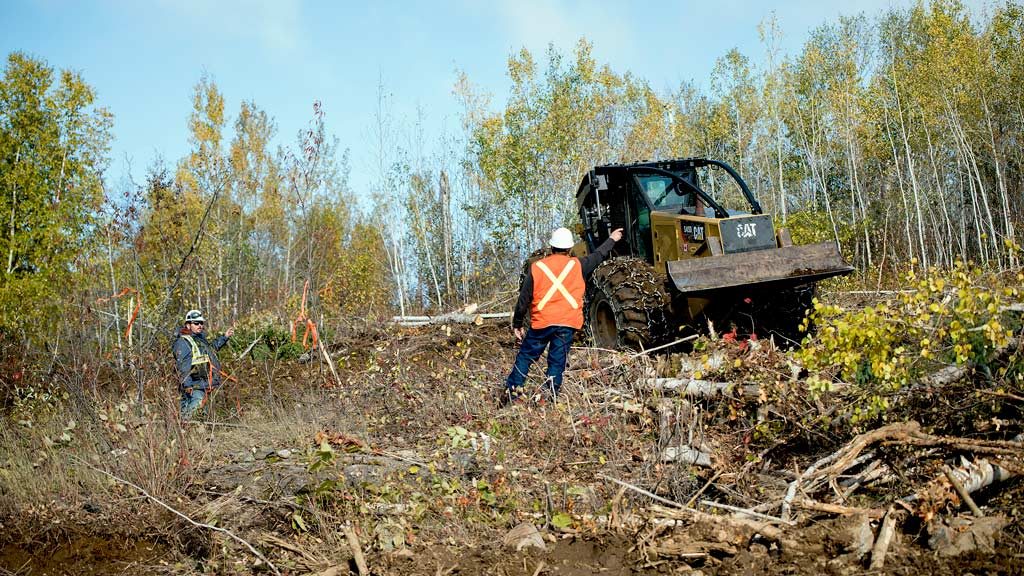Right-of-way clearing and access road construction has started for a $777-million, 450-kilometre-long transmission line that will follow the Lake Superior shoreline from Thunder Bay to Wawa in Northwestern Ontario.
Work on a temporary camp is starting in Nipigon, and others are planned along the route for Marathon, White River and at Wawa. Steel for the towers is being stored at a laydown yard in Thunder Bay.
The long-awaited, double-circuit, 230-volt infrastructure venture, dubbed the East-West Tie Line Transmission Project, is deemed vital to growth in the region. It is being built by NextBridge Infrastructure and is one of the largest investments in the electricity system in Northwestern Ontario in decades.
Jennifer Tidmarsh, project director and president of NextEra Transmission Canada, says the company is delighted to have shovels in the ground to give the region the reliable energy it needs to grow and prosper.
NextBridge has trained over 200 Indigenous people to work on the project
— Jennifer Tidmarsh
NextEra Transmission Canada
“Economic development in the northwest, particularly in the mining and resource sector, is expected to drive strong electricity demand in the coming decade. The East-West Tie Line Transmission Project is required to ensure the long-term reliability of the electricity supply in the northwest to power this growth,” says Tidmarsh.
The line will connect the Lakehead Transformer Station in the Municipality of Shuniah east of Thunder Bay to a transformer station in Wawa. The build will take more than two years and the line will be energized by the end of 2021.
The project is expected to have an average daily workforce of about 230 and 700 at the peak of construction.
Tidmarsh says NextBridge has worked closely with Indigenous communities along the project right-of-way and they formed the Bamkushwada Limited Partnership which, in turn, owns Supercom Industries which will select and hire the suppliers and contractors for the project with a focus on Indigenous workers.
“Through this partnership, NextBridge has trained over 200 Indigenous people to work on the project and once the line goes into service, Bamkushwada will have the option to become economic partners in the East-West Tie,” she says.
The project will have 11 work fronts and generally begin at the west end of the line and progress easterly. The build has started and work will begin on other work fronts as permits are acquired.
The work will move along the corridor in phases similar to highway construction. First, a right-of-way and access roads are built, surveys are conducted to confirm tower locations, then materials are delivered, foundations and anchors for the towers are installed, and the towers are set into place with cranes or helicopters.
Crews will assemble the tower structures by bolting together steel angles per the design drawings and a crane or helicopter will then set the structure on the foundation and the crew will attach holding components.
For easily accessed areas, structures or structure sections may be assembled at laydown yards and brought to the site via truck using access roads erected onsite. Flatbed trucks and erection cranes will be used. After the tower structure is set in place, the crew then installs and tensions guy wires if necessary.
Stringing and fastening the conductor wire to the towers then takes place in the opposite direction of construction. In other words, crews will work back to the start of the work fronts.
After construction is completed, sites will be returned as close as possible to their original ground conditions.
The project has been in the works for six years. It has been identified as a priority project by the province and the Independent Electricity System Operator to meet future electricity demand in Northwestern Ontario.
In addition to the Indigenous communities, NextBridge worked closely with municipalities, landowners, community members and businesses along the route.
“The East-West Tie project offers an example of how industry and Indigenous communities can work together to build infrastructure while providing local economic benefits and respecting First Nation culture,” said Peter Collins, chief of Fort William First Nation and president of Bamkushwada. “Along with growth opportunities this project brings to the region, it has also helped us build capacity for community members that provide benefits long after the project is complete.”
Earlier this year, the province moved the project ahead by scuttling the Ontario Energy Board’s review of the venture, as it was taking longer than expected which was putting timely construction at risk and potentially increasing costs for electricity customers. The announcement ended a bid by Hydro One to build the line.
The government noted NextBridge had completed significant preliminary work on the project and had consulted extensively with local First Nations and Metis communities.











Thunder Bay should convert from coal to Alberta natural gas, the people down wind in Nova Scotia would appreciate it.